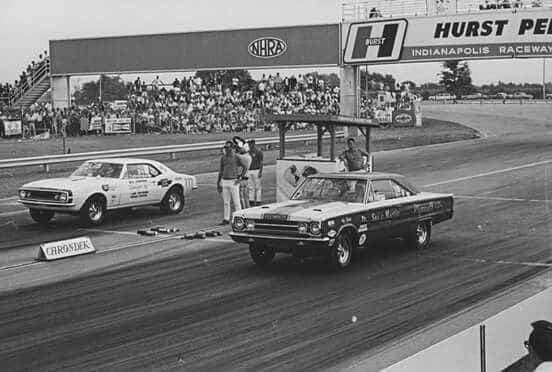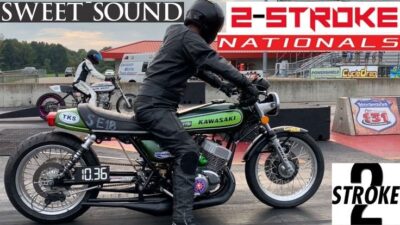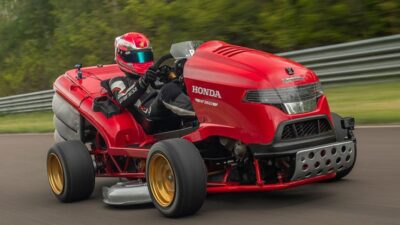Drag racing represents one of motorsport’s purest forms of competition, where drivers test their vehicles in straight-line acceleration battles. Many enthusiasts begin with street racing before discovering the safer, more organized world of sanctioned drag strips.

The transition from street to strip racing opens up new possibilities for performance modifications while providing a controlled environment for testing vehicle limits. Street/strip builds require specific modifications that balance daily driving needs with track performance capabilities.
Modern drag racing has evolved significantly, with shows like Street Outlaws helping to move racing from illegal street venues to sanctioned tracks. This shift has brought millions of new fans to the sport while maintaining the raw excitement that makes drag racing so appealing.
Key Takeaways
- Drag racing provides a controlled environment for testing vehicle performance compared to dangerous street racing
- Successful street/strip builds require careful balance between daily driving comfort and track performance modifications
- Proper safety equipment and track preparation are essential for transitioning from street racing to sanctioned drag strips
Understanding Drag Racing
Drag racing represents a pure test of acceleration where two vehicles compete head-to-head down a straight track. The sport has grown from informal street racing into organized professional events while maintaining dual-purpose street/strip vehicles that bridge both worlds.
Core Principles of Drag Racing
Drag racing is an acceleration contest between two vehicles starting from a complete stop. The goal is simple: reach the finish line first over a measured distance.
Most drag strips use a quarter-mile distance (1,320 feet). Some tracks also offer eighth-mile racing for beginners or specific vehicle classes.
The competition follows a tournament-style elimination format. The losing racer in each contest is eliminated, and winning racers advance until one remains.
Key measurements include:
- Elapsed Time (ET) – Total time from start to finish
- Trap Speed – Speed measured at the finish line
- Reaction Time – Driver’s response to the starting signal
Races begin with a “Christmas Tree” starting system. This device uses amber and green lights to signal the start sequence.
Exploring Street/Strip Dual Purpose Cars
Street/strip vehicles serve dual roles as both daily drivers and drag racing machines. Street cars can get registered and will see street driving conditions with appropriate tires and suspension.
These cars must balance performance modifications with street safety requirements. They need functional headlights, turn signals, and other road-legal equipment.
Common street/strip modifications include:
- Engine tuning for pump gas compatibility
- Suspension that handles both launches and cornering
- Tires suitable for street driving and track use
- Safety equipment meeting track requirements
Strip cars see track only and focus purely on performance. Street/strip builds compromise between maximum performance and daily usability.
Many racers start with street/strip vehicles before moving to dedicated race cars. This approach allows learning fundamentals while maintaining a practical vehicle.
Evolution from Street Racing to Professional Strip Events
Drag racing began with informal street racing where drivers tested their cars on public roads. This dangerous practice moved to controlled environments as organized racing developed.
Professional drag strips emerged to provide safe, legal venues for competition. Drag racing has evolved to become a family-friendly sport where craftsmanship and skill are tested.
Modern drag racing includes multiple professional classes:
- Top Fuel – The fastest accelerating vehicles
- Funny Car – High-performance with unique body styles
- Pro Stock – Factory-based vehicles with modifications
Each race is driven on a drag strip inside a stadium with proper safety equipment and emergency crews. Professional events feature precise timing systems and standardized rules.
Street racing continues to influence strip racing culture. Many professional racers began on the streets before transitioning to sanctioned competition.
The sport now attracts participants from weekend warriors to professional teams with million-dollar budgets.
Getting Started: Transitioning from Street to Strip
Moving a car from street driving to drag racing requires specific changes to meet track safety rules and boost performance. The key areas include making essential modifications, understanding different build approaches, and picking the right track for your experience level.
Essential Modifications for Street/Strip Vehicles
Safety equipment forms the foundation of any street to strip car build. Most tracks require a helmet rated for motorsports use, even for beginner runs.
Cars running faster than 13.99 seconds need additional safety gear. This includes a roll bar, racing harness, and fire extinguisher mounted in the car.
Basic Safety Requirements:
- DOT-approved helmet (minimum)
- Long pants and closed-toe shoes
- Valid driver’s license
- Street-legal registration and insurance
Performance modifications can start simple and grow over time. Must-have mods for street-to-strip builds include drag radial tires for better traction and a transmission cooler to handle the heat from repeated hard launches.
Engine modifications should focus on reliability first. Cold air intakes, exhaust systems, and tune-ups provide gains without major changes to the car’s daily driving ability.
Suspension adjustments help with launch consistency. Adjustable rear shocks allow drivers to dial in the right amount of weight transfer for their specific car and track conditions.
Key Differences Between Street and Dragstrip Builds
Street cars and strip cars serve different purposes and require different approaches. Street cars must handle daily driving conditions like stop-and-go traffic, turns, and various weather conditions.
Strip-only cars focus purely on straight-line performance. They can use racing fuel, have loud exhausts, and run modifications that would make street driving difficult or impossible.
Street/Strip Compromise:
| Street Priority | Strip Priority | Balanced Approach |
|---|---|---|
| Comfort | Maximum power | Adjustable suspension |
| Fuel economy | Weight reduction | Removable interior |
| Quiet operation | Loud exhaust | Exhaust cutouts |
| All-weather tires | Drag slicks | Drag radials |
Street/strip builds require careful planning. Drivers need cars that can handle weekend track duty while remaining comfortable for daily use.
Weight reduction helps both street and strip performance. Removing spare tires, rear seats, and excess items improves acceleration without hurting street manners.
Gear ratios affect both applications differently. Street cars benefit from highway-friendly ratios, while strip cars want aggressive gearing for quick acceleration.
Choosing the Right Racing Venue
Beginners should start with test-and-tune nights at local tracks. These events provide a relaxed environment to learn drag racing basics without pressure from competition.
Most tracks offer beginner programs that include safety briefings and coaching. These sessions teach proper staging procedures, reaction times, and track etiquette.
Track Types for New Racers:
- Test & Tune: Open practice with minimal rules
- Bracket Racing: Handicapped racing based on dial-in times
- Street Car Nights: Events specifically for unmodified vehicles
- No-Prep Events: Racing on unprepared track surfaces
Track preparation varies between venues. Some facilities offer excellent traction with VHT compound and track prep, while others provide more challenging conditions.
Distance options include eighth-mile and quarter-mile tracks. Eighth-mile racing requires less power and puts less stress on vehicles, making it ideal for newer racers.
Safety rules differ between tracks and sanctioning bodies. Drivers should contact their chosen facility before their first visit to understand specific requirements for their car’s performance level.
Performance Fundamentals: Weight Transfer and Traction
Weight transfer fundamentals determine traction limits during acceleration, while proper suspension tuning maximizes grip potential without sacrificing daily driving comfort.
How Weight Transfer Affects Launch and Acceleration
When a drag car accelerates, weight transfers from the front to the rear wheels. This shift increases the vertical force on the drive tires. More weight on the rear tires means more grip.
The physics follows Newton’s Second Law with the equation F=ma. Traction depends on two main factors: the coefficient of friction between tire and track, plus the vertical force pressing down on the tire.
Weight Transfer Benefits:
- Increases rear tire grip
- Reduces front wheel spin potential
- Improves launch consistency
Cars with open differentials face additional challenges. The driveshaft torque reaction can lift weight off one rear tire. This reduces total traction since the differential sends power to the wheel with less grip.
Locked differentials eliminate this problem. Both rear wheels maintain equal traction throughout the launch phase.
Optimizing Suspension for Strip Performance
Spring rates and shock settings control weight transfer speed. Softer rear springs allow more weight transfer but can cause excessive body movement.
Key Suspension Adjustments:
| Component | Strip Setting | Effect |
|---|---|---|
| Rear Springs | 15-20% softer | More weight transfer |
| Front Springs | 10-15% stiffer | Controls nose dive |
| Rear Shocks | Less compression, more rebound | Controls tire contact |
| Front Shocks | More compression | Slows weight transfer |
Shock tuning becomes critical on marginal surfaces. Less compression with more rebound helps the car settle over the rear tires during launch.
Anti-roll bars affect lateral weight transfer across the axle. Increasing rear roll stiffness can improve traction with open differentials. Front anti-roll bars should be minimized to allow maximum weight transfer.
Balancing Street Comfort with Track Capability
Street cars need suspension settings that work for both environments. Adjustable components offer the best solution for dual-purpose vehicles.
Coilover systems allow spring rate changes between street and strip use. Many racers run softer settings on the street, then increase preload at the track.
Dual-Purpose Setup Guidelines:
- Use adjustable shocks with multiple settings
- Install removable front anti-roll bar
- Consider air bag systems for rear height control
- Keep rear spring rates within 25% of stock
Electronic shock systems provide real-time adjustment capability. Drivers can switch between comfort and performance modes instantly.
Weight placement modifications work well for both applications. Moving the battery to the trunk improves weight distribution without affecting ride quality. This change helps launch performance while maintaining street manners.
Tires and Wheels for Street/Strip Use
The right tire and wheel setup balances daily driving comfort with track performance, requiring specific sizing strategies and weight considerations. Proper wheel and tire selection can reduce rotating mass by 22 pounds while maintaining street safety standards.
Selecting Tire Size for Maximum Traction
Front tire sizing focuses on reducing weight and rolling resistance. Most street/strip builds benefit from 15×3.75-inch wheels with skinny front-runner tires.
These narrow tires cut unsprung weight significantly. They also help with weight transfer during launches.
Recommended Front Sizes:
- 15×3.75-inch (ideal)
- 17×4.5-inch to 18×5-inch (larger brake clearance)
Rear tire sizing prioritizes contact patch and power handling. Matching wheel and tire combinations with horsepower output prevents wheel spin and maximizes traction.
Recommended Rear Sizes:
- 15×10-inch (preferred)
- 17×9.5-inch to 17×10.5-inch (modern muscle cars)
Tire size affects performance more than appearance. Wider rear tires handle more power effectively than narrow ones.
Understanding Differences Between Street and Track Tires
Drag radials offer superior traction over standard street tires while maintaining DOT approval for legal street use. They use softer compounds that heat up for better grip.
Street tires prioritize longevity and wet weather performance. They have harder compounds that resist wear but provide less grip.
Track-Focused Features:
- Softer rubber compounds
- Wider contact patches
- Lower air pressure capability
- Heat cycling tolerance
Air pressure adjustments optimize performance for each environment. Street driving requires higher pressures for load capacity and safety.
Track use benefits from lower pressures that increase tire flex. This flex helps absorb power and improves traction during launches.
DOT-approved drag radials bridge the gap between pure race slicks and street tires. Popular options include Mickey Thompson ET Street R and Nitto drag radials.
Optimizing Wheel Selection for Performance
Weight reduction drives wheel selection for street/strip use. Lightweight wheels improve weight transfer efficiency and reduce rotating mass.
Factory wheels typically weigh 20+ pounds each. Performance wheels can weigh as little as 12 pounds in front applications.
Weight Comparison:
| Wheel Type | Front Weight | Rear Weight |
|---|---|---|
| Stock | 20+ lbs | 20+ lbs |
| Race Star 15×3.75 | 12 lbs | N/A |
| Race Star 15×10 | N/A | 17 lbs |
Street/strip wheels must pass DOT J2530 testing for road use. This testing ensures they handle potholes and curb impacts safely.
Race-only wheels are 10% lighter but lack street durability. They cannot handle daily driving stresses reliably.
Brake clearance determines minimum wheel diameter. Modern muscle cars often require 17-inch or larger wheels for brake clearance.
Smaller diameters allow larger tire sidewalls that absorb launch forces better. The trade-off between clearance and performance requires careful measurement.
Powertrain and Drivetrain Upgrades
Moving power from the engine to the wheels requires careful attention to transmission ratios, cooling systems, and power transfer components. Each element must handle increased horsepower while maintaining reliability for both street driving and track performance.
Transmission and Gear Ratio Considerations
Automatic transmissions dominate drag racing because they provide consistent shifts and better power multiplication through torque converters. The TH400, 4L80E, and Powerglide remain popular choices for their durability and aftermarket support.
Manual transmissions work well for street/strip applications but require more skill to achieve consistent times. A Muncie M22 or TKO transmission can handle moderate power levels while keeping the car streetable.
Gear ratios play a crucial role in acceleration. Lower numerical rear gear ratios like 4.10:1 or 4.56:1 help cars launch harder from the starting line. Higher ratios sacrifice top speed for better acceleration through the traps.
Popular Transmission Options:
- Powerglide: Simple, lightweight, handles high power
- TH400: Three speeds, very durable, heavier than Powerglide
- 4L80E: Electronic control, overdrive for street driving
- Manual: Better for street use, requires skilled driver
Cooling and Lubrication Essentials
High-performance engines generate extreme heat that stock cooling systems cannot handle. Aluminum radiators with increased core thickness and electric fans provide better heat rejection than factory units.
Transmission coolers prevent fluid breakdown during repeated hard launches. An auxiliary cooler with a thermostat maintains proper operating temperature while preventing overcooling on the street.
Oil cooling becomes critical with forced induction or high-revving engines. External oil coolers and accusumps help maintain pressure during hard acceleration when oil moves away from the pickup.
Cooling System Upgrades:
- Aluminum radiator with 2-3 inch core
- Electric fans for consistent airflow
- Transmission cooler with thermostat
- Oil cooler for high-power applications
- Accusump for oil pressure stability
Clutch, Converter, and Differential Choices
Upgraded clutch systems must handle increased torque without slipping. Multi-disc clutches or single-disc units with ceramic or metallic friction materials work well for street/strip use.
Torque converters multiply engine torque and allow automatic transmissions to build boost pressure with turbocharged engines. Stall speeds between 3,000-5,000 RPM work well for most applications. Higher stall converters launch harder but reduce street drivability.
Limited-slip differentials prevent one-wheel burnouts and improve traction. Clutch-type units like the Auburn Pro or Detroit Locker provide good street manners with effective power transfer.
Power Transfer Components:
- Clutch: Ceramic or metallic materials for durability
- Converter: 3,000-5,000 RPM stall for most builds
- Differential: Limited-slip for traction improvement
- Axles: Upgraded units for high-torque applications
Safety Measures and Track Preparation
Proper safety equipment and thorough vehicle preparation are essential requirements for any drag racing event. Most tracks require specific gear based on your car’s performance level, while comprehensive pre-race inspections ensure both driver and vehicle meet minimum safety standards.
Required Safety Equipment for Drag Racing
NHRA drag racing safety requirements mandate specific clothing and protective gear for all participants. Drivers must wear long pants, closed-toe shoes, socks, and shirts with sleeves. Tank tops, shorts, and sandals are strictly prohibited.
Helmet requirements depend on your car’s elapsed time. DOT-approved helmets work for cars running 14 seconds or slower. Faster vehicles need Snell SA or SFI-certified helmets.
Performance-Based Safety Requirements:
| Quarter Mile Time | Required Equipment |
|---|---|
| 14.00+ seconds | DOT helmet, basic clothing |
| 13.99-11.50 seconds | Snell/SFI helmet |
| 11.49-10.00 seconds | Roll bar (convertibles at 13.49) |
| 9.99 seconds or faster | Full-face helmet, roll cage |
Cars exceeding 135 mph require competition licenses. Roll cages become mandatory for vehicles running 10.99 seconds or quicker.
Track Day Checklist for Street/Strip Cars
Basic NHRA safety inspections cover essential vehicle components before allowing track access. Officials examine battery hold-downs, seat belts, brakes, and tire condition during tech inspection.
Pre-Race Vehicle Requirements:
- Secure battery mounting with proper hold-down
- Working seat belts and neutral safety switch
- Good tire condition with adequate tread
- Radiator overflow catch can installed
- No fluid leaks under the vehicle
Remove all loose items from the cabin and trunk. Floor mats, tools, water bottles, and personal belongings can become dangerous projectiles at high speeds.
Turn off air conditioning systems to prevent water dripping onto the track surface. Check that throttle linkage returns properly to idle position.
Required Documentation:
- Valid driver’s license
- Vehicle registration and insurance
- Medical clearance (if required by track)
Most facilities welcome street-legal vehicles for test-and-tune sessions without extensive modifications. Automatic transmissions must only start in Park or Neutral positions.
Frequently Asked Questions
New racers often wonder about the legal ways to get into drag racing and what equipment they need. Most questions focus on vehicle requirements, safety gear, and finding nearby tracks.
What are the key differences between street racing and sanctioned drag racing events?
Street racing happens on public roads without permission and is illegal. It puts drivers and the public at risk. Sanctioned drag racing takes place at official tracks with safety equipment and trained staff.
Sanctioned drag racing events follow strict rules and safety standards. Track officials inspect cars before races. Medical crews stay on site during events.
Street racing has no safety rules or emergency help nearby. Sanctioned events provide barriers, safety crews, and proper racing surfaces designed for high speeds.
How can one legally participate in drag racing?
The cheapest way to start is through street legal drag events at local tracks. Many tracks offer Friday night street legal racing where drivers can race their regular cars.
Drivers need a valid license and must pass a basic safety inspection. Some tracks require helmets for cars running certain times. Most tracks charge an entry fee between $20-50 per night.
Racers can also join racing organizations like NHRA or IHRA. These groups have more rules but offer bigger events and championships.
What are the safety requirements for participating in drag racing?
Basic safety items include battery hold downs, radiator overflow bottles, and helmets when required. Faster cars need more safety equipment like roll bars and fire suits.
NHRA has specific safety rules based on how fast cars run. Cars running under 13.99 seconds need helmets. Faster times require more safety gear.
All cars must pass tech inspection before racing. Officials check for loose parts, proper battery mounting, and working brakes.
What types of vehicles are typically used in competitive drag racing?
Drag racing welcomes many types of vehicles. Street cars, muscle cars, and purpose-built race cars all compete at different levels.
Strip cars only see track use and have extensive modifications. Street cars must remain street legal and driveable on roads.
Common categories include stock cars, modified street cars, and full race cars. Each class has rules about allowed modifications and safety equipment.
How does one find local drag racing events and tracks?
Most drag strips have websites listing their racing schedules and events. Social media pages also show upcoming races and special events.
Racing organizations like NHRA and IHRA list sanctioned tracks on their websites. Local car clubs often know about nearby tracks and events.
Many tracks offer beginner-friendly events designed for new racers. These events include instruction and have relaxed rules.
What modifications are commonly made to vehicles for improved performance in drag racing?
Engine modifications focus on increasing horsepower through better air flow and fuel delivery. Common upgrades include cold air intakes, exhaust systems, and engine tuning.
Tire upgrades provide better traction at the starting line. Drag radials or slick tires grip better than regular street tires.
Suspension modifications help transfer weight to the rear wheels for better launches. Some racers also remove weight from their cars to improve performance.










